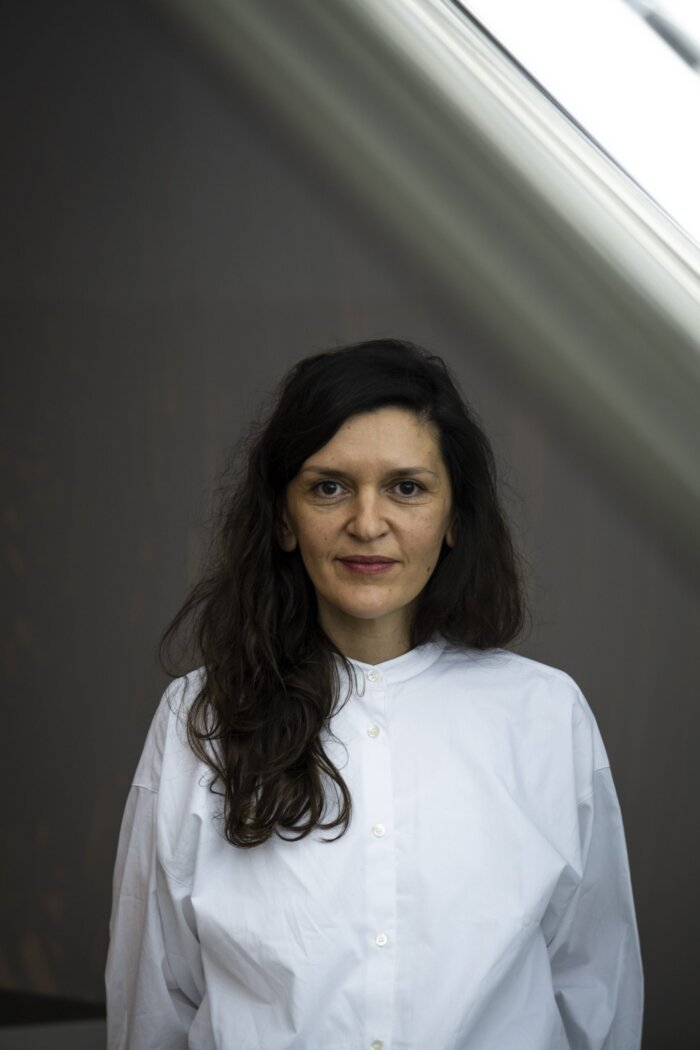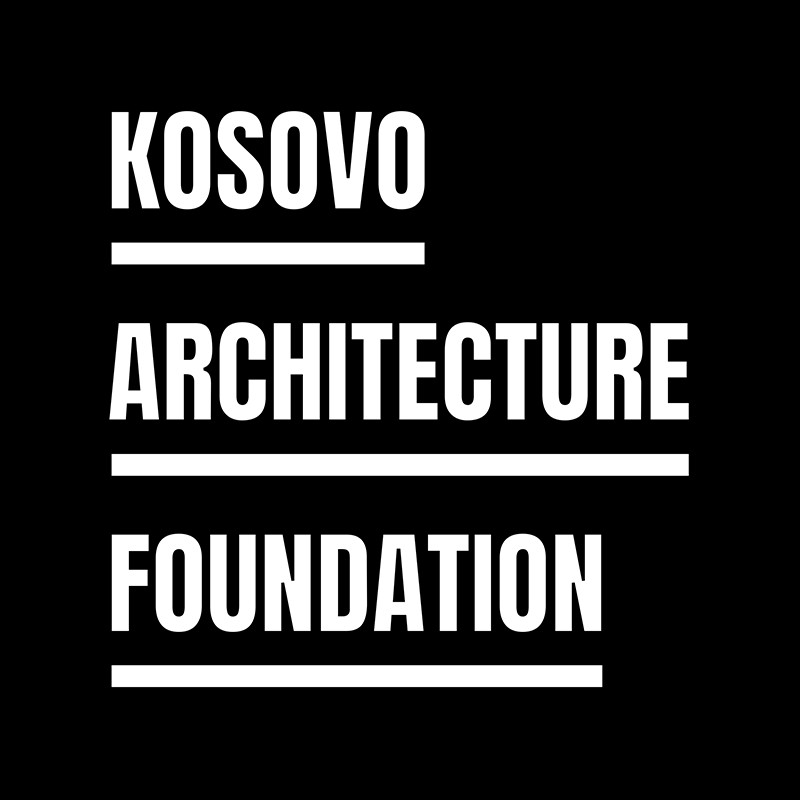

PARK THE PARKING WORKSHOP WITH ANA GALLEGO
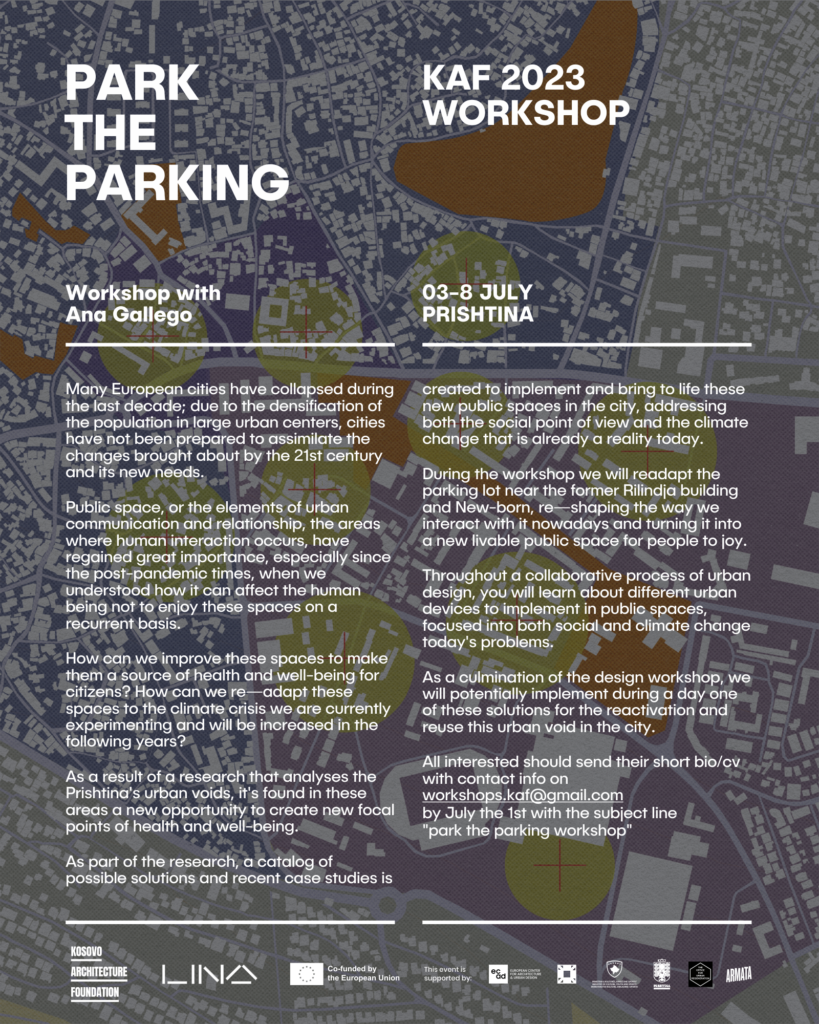



EN/
Prishtina Architecture Tour
Time and Place: 5th of July 2023 from 3PM at Brotherhood & Unity Monument
Join us for the insightful Prishtina Architecture Tour and learn more about Prishtina’s landmarks from the Sultans Mosque to the National Library. Prishtina has a vast architecture history spanning from the Ottoman period presented in the most unique form through some of the oldest Mosques in Europe, up to the Socialist Era and its world unique Brutalist marvels such as the Youth and Sports Center. The architecture tour starts from the Brotherhood & Unity Monument and ends at the National Library.
AL/
Turneu Arkitektonik i Prishtinës
Koha dhe Vendi: 5 Korrik 2023 nga ora 15:00, nisja nga monumenti i Bashkim Vllaznimit
Bashkohuni me ne për turneun e vecant të arkitekturës në Prishtinë dhe mësoni më shumë për monumentet e Prishtinës nga Xhamia e Sulltanëve deri tek Biblioteka Kombëtare. Prishtina ka një histori të gjerë arkitekturore që shtrihet nga periudha osmane e paraqitur në formën më unike përmes disa prej xhamive më të vjetra në kontinentin tonë e deri tek epoka socialiste dhe mrekullitë e saj brutaliste të vecanta në botë sikurse Qendra Rinore dhe Sportive. Turi i arkitekturës fillon nga monumenti i Bashkim Vllaznimit dhe përfundon në Bibliotekën Kombëtare.

EN/
Nomma Open Studio Visit
Time and Place: 7th of July 2023 from 3PM Nomma Studio
Welcome to NOMMA studio, the vibrant architectural powerhouse rewriting the rules of design from the heart of Pristina. We’re more than architects – we’re audacious innovators, fearlessly redefining the balance between style and substance. Our work cuts a swath across the interior design, blending functionality and aesthetics into breath-taking residential, commercial, and institutional projects.
Our influence isn’t confined by borders – our award-winning creations echo from Southeast and Western Europe, making waves on the global stage. Packed with accolades and spotlighted in top-tier publications, nomma Studio is a creative hub where avant-garde design collides with daring innovation.
Every line we draw, every space we craft, emanates from a team of maverick designers committed to pushing boundaries. At NOMMA studio, we’re not just designing buildings; we’re sparking dialogues, challenging norms, and leaving indelible footprints on the sands of architectural time.
AL/
Nomma Open Studio Vizita
Koha dhe Vendi: 7 Korrik 2023 nga 15:00 tek Nomma Studio
Mirë se vini në studio NOMMA, qendra energjike arkitekturore që rishkruan rregullat e dizajnit nga zemra e Prishtinës. Ne jemi më shumë se arkitektë – ne jemi inovatorë të guximshëm, duke ripërcaktuar pa frikë ekuilibrin midis stilit dhe substancës. Puna jonë ndan një brez në dizajnin e brendshëm, duke përfshirë funksionalitetin dhe estetikën në projekte rezidenciale, tregtare dhe institucionale marramendëse.
Ndikimi ynë nuk kufizohet nga kufijtë – krijimet tona të vlerësuara me çmime jehojnë nga Evropa Juglindore dhe Perëndimore, duke bërë valë në skenën globale. I mbushur me vlerësime dhe i vënë në qendër të vëmendjes në botimet e nivelit të lartë, nomma Studio është një qendër krijuese ku dizajni avangardë përplaset me inovacionin e guximshëm.
Çdo linjë që vizatojmë, çdo hapësirë që krijojmë, buron nga një ekip projektuesish të jokonformistë të përkushtuar për të shtyrë kufijtë. Në studion NOMMA, ne nuk jemi vetëm duke projektuar ndërtesa; ne po ndezim dialogë, po sfidojmë normat dhe po lëmë gjurmë të pashlyeshme në rërën e kohës arkitekturore.



EN/
Dieform Open Studio Visit
Time and Place: 6th of July 2023, 3PM at Dieform Studio
Dieform is an interdisciplinary research center for experimental architecture, design and contemporary art. It is an experimental space for interdisciplinary collaboration, study and research of [in]formative design solutions: their transient nature, and the ways they relate to everyday functions. It aims to change physical and cultural landscapes of Kosovo cities and beyond by creating socially and environmentally aware solution – from inception to application. We design with people for people- this includes proposing and creating content together with them, as a fully combination between personal desires and professionalism/expertise.
TRINOM Philosophy: RESEARCH-EDUCATION-DESIGN
Dieform education aims to provide a range of educational programs covering the fields of Architecture, Design and Arts, with a particular focus on master programs. Its vision is to provide next generations with study experiences which are based on critical thinking, creativity and place-based solutions.
AL/
Dieform Open Studio Vizita
Koha dhe Vendi: 6 Korrik 2023 nga ora 15:00 tek Dieform Studio
Dieform studio është një qendër kërkimore ndërdisiplinore për arkitekturën eksperimentale, dizajnin dhe artin bashkëkohor.
Është një hapësirë eksperimentale për bashkëpunim ndërdisiplinor, studim dhe hulumtim të zgjidhjeve të projektimit [in]formativ: natyrës së tyre kalimtare dhe mënyrat se si ato lidhen me funksionet e përditshme.
Synimi është të ndryshohen peizazhet fizike dhe kulturore të qyteteve të Kosovës dhe më gjerë duke krijuar zgjidhje të vetëdijshme shoqërore dhe mjedisore – nga fillimi deri në aplikim.
Ne projektojmë me njerëz për njerëzit – kjo përfshin propozimin dhe krijimin e përmbajtjes së bashku me ta, si një kombinim i plotë midis dëshirave personale dhe profesionalizmit/ekspertizës.
TRINOM Filozofia: KËRKIM-ARSIM-DIZAJNIM
Edukimi Dieform synon të ofrojë një sërë programesh arsimore që mbulojnë fushat e Arkitekturës, Dizajnit dhe Arteve, me fokus të veçantë në programet master. Vizioni i saj është t’u sigurojë gjeneratave të ardhshme përvoja studimore të cilat bazohen në të menduarit kritik, kreativitetin dhe zgjidhjet e bazuara në vend.


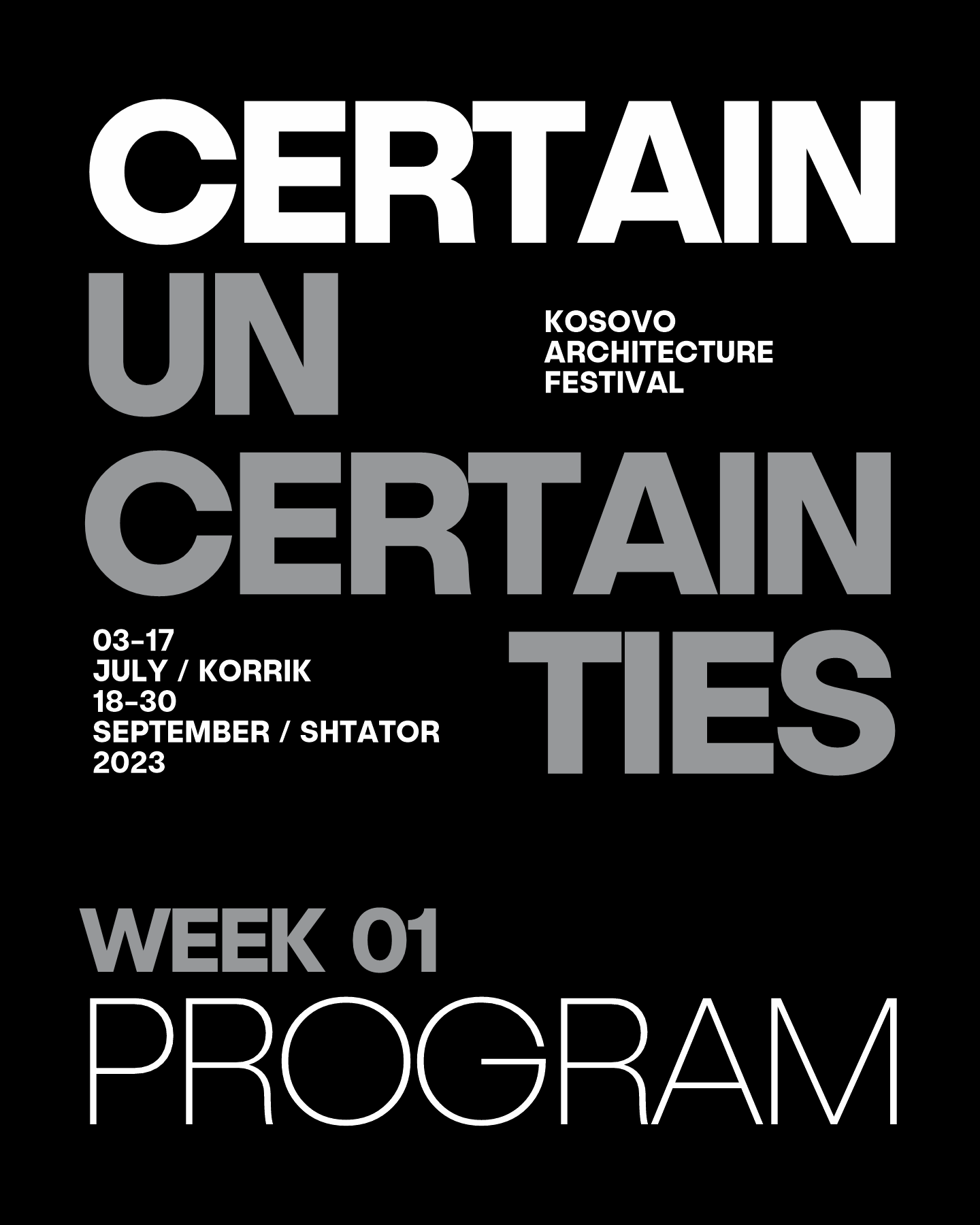


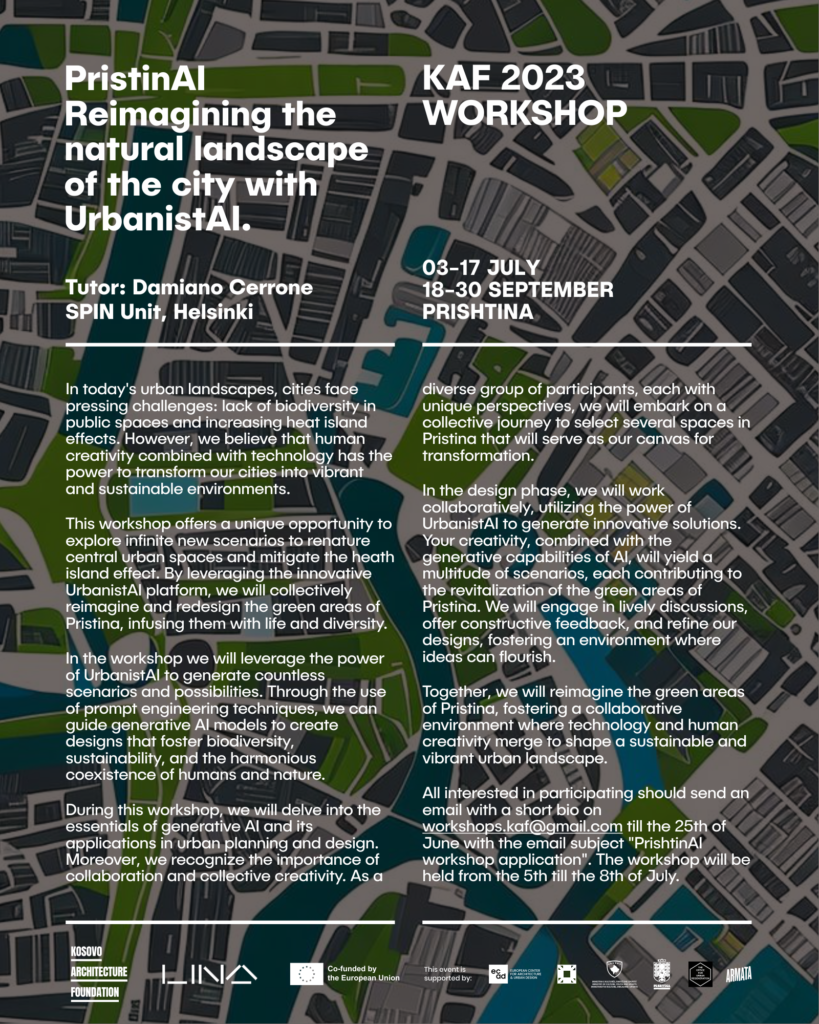

EN/
This year the Kosovo National Pavilion at the Venice Biennale will be curated by the duo Poliksen Qorri Dragaj & Hamdi Qorri.
Up to the present day, migration plays a significant role in the social development of Kosovo. It manifests itself in different forms, which differ in motives, manner and duration. The exhibition deals with a special form of migration, which illustrates that the migratory process is not completed with the simple move to another country. It often takes place in different phases, some of which end in a return to the home country. This return can be temporary, seasonal or permanent, but what they all have in common is that they ensure that connections and networks of different kinds are created between the homeland and the hostland. This form of migration can be described with the concept of translocality, a model of life that is becoming more and more prevalent – people living in multiple places at the same time, maintaining connections between hostland and homeland through communication, transfer of knowledge, information, material and immaterial goods.
In the course of the tense political situation and an ever-worsening marginalization of the Albanian population during the breakdown of the Yugoslavian Republic, hundreds of thousands of people sought refuge and protection abroad. In some cases, this flight would often last for decades without return.
During this conflict- and war-related migration wave in the late 1980s to the late 1990s, people fleeing found temporary arrival mostly in OECD countries, regulated in the form of a residence permit as politically persecuted persons. This legal status did not provide for a return to the homeland as long as the reason for flight had not been resolved and lifted. For many refugees, this represented a state of waiting and lingering, because the reason for migration was not a self-determined one – on the contrary, it was violently imposed from the outside.
The perceived locality of this migration group is the starting point for a spatial-philosophical narrative: transcendent locality. The concept of transcendence is variously described and defined from ancient to contemporary philosophy. Common to all meanings is that transcendence implies the process of crossing a boundary that separates two fundamentally different spheres.
For the individuals living in migration, the circumstance of not being able to return to their homeland for an indefinite period represented a deep caesura in their lives. On the one hand, the migrated individuals were physically present in the hostlands. superficially managing their everyday life and functioning in their new environment. But on the other hand, the emotional presence was a different matter: due to the conflict, attention and thoughts revolved around the abandoned homeland, fears and insecurities often did not allow the individuals to arrive in the hostland. They were located in an intermediate state between the physical present and the abandoned before. In this state, boundaries between the immanent being in the present and the transcendent being in the mind blur – the migrated individual is in a transcendent locality.
This project explores the impact of transcendent locality on immanent space in the short and long term: how the return of migrants after the war has affected Kosovar cities and how the social migration networks, which developed in the hostlands, impact on urban space in the form of translocal urbanism. It opens discussions on how urban planning can respond to these specific conditions in order to create urban resilience and liveable cities.
//
The installation serves as a metaphor for the idea of transcendence – the physical representation of a subjective state. It consists of an outer and an inner frame made of aluminium, in the middle of which a further frame made of neon tubes is located. All of these are multiplied horizontally.
Fragments
The installation is modularly assembled from individual parts. In the context of the project, this is how the transcendent locality is also composed. Individual fragments of memories and stories from the homeland are complemented by new impressions and experiences in the hostland and embed the transcendent locality in it. Memories and new impressions mean that this place is subject to a constant dynamic and never reaches a final state.
In between
Through migration, the center of life is left behind and, with increasing time, is supplemented by a second home in the hostland – this can be seen as a gain. Translocality, however, also strengthens the state of being in between.
The exterior and interior frames pick up on this motif as fixed constructions, in which the feeling of being in between is picked up by the neon.
Multiplication
The subjective confrontation and reflection with one’s own transcendent and immanent location in the context of migration is repeated again and again and becomes a constant companion.
The installation as a physical construct and as a metaphor depends very much on the individual perspective. Viewed from a distance, fragments, layers and spaces in between result in a coherent picture and, conversely, dissolve into their individual parts with increasing proximity – similar to the transcendent locality, which transforms into translocality and no longer lets people leave the intermediate state of proximity and distance between two places of being at home.
AL /
Këtë vit paviljoni i Republikës së Kosovës në Bienalën e Venecias do kurohet nga ekipi i arkitektëve dhe kuratorve Poliksen Qorri Dragaj & Hamdi Qorri.
Deri më sot, migrimi ka pasur rol të rëndësishëm në zhvillimin social të Kosovës. Manifestohet në forma të ndryshme, të cilat dallojnë për kah motivet, mënyra dhe kohëzgjatja. Ekspozita trajton një formë të veçantë të migrimit, e cila ilustron se procesi i migrimit nuk përfundon me shpërnguljen e thjeshtë në një vend tjetër. Shpesh zhvillohet në faza të ndryshme, disa prej të cilave përfundojnë me kthimin në vendlindje. Ky kthim mund të jetë i përkohshëm, sezonal ose i përhershëm, por e përbashkëta e tyre është se ato bëjnë të mundur krijimin e lidhjeve dhe rrjeteve të llojeve të ndryshme midis vendlindjes dhe vendit emigrues. Kjo formë migrimi mund të përshkruhet me konceptin e translokalitetit, një model jete që po bëhet gjithnjë e më i përhapur – njerëzit që jetojnë në shumë vende në të njëjtën kohë, duke ruajtur lidhjet midis vendlindjes dhe vendit emigrues përmes komunikimit, transferimit të njohurive, informacionit, të mirave materiale dhe jomateriale.
Në rrjedhën e situatës së tensionuar politike dhe një margjinalizimi të përkeqësuar të popullsisë shqiptare gjatë shpërbërjes së Republikës Jugosllave, qindra mijëra njerëz kërkuan strehim dhe mbrojtje jashtë vendit. Në disa raste, kjo ikje shpesh do të zgjaste për dekada pa kthim.
Gjatë kësaj vale të migrimit për shkak të konfliktit dhe luftës në fund të viteve ‘80 deri në fund të viteve ‘90, njerëzit që iknin gjetën strehim të përkoshëm kryesisht në vendet e OBZE-së, të rregulluar në formën e një leje qëndrimi si persona të përndjekur politikë. Ky status ligjor nuk parashihte kthim në vendlindje për sa kohë nuk i ishte dhënë zgjdihje dhe fund arsyes së ikjes. Për shumë refugjatë, kjo përfaqësonte një gjendje pritjeje dhe ngecjeje, sepse arsyeja e migrimit nuk ishte nga vetëdëshira– përkundrazi, ajo ishte e imponuar me dhunë nga jashtë.
Lokaliteti i perceptuar i këtij grupi migrues është pikënisja për një narrativë hapësinore-filozofike: lokalitet transcendent. Koncepti i transcendencës përshkruhet dhe përkufizohet në mënyra të ndryshme që nga filozofia e lashtë e deri në atë bashkëkohore. E përbashkët për të gjitha kuptimet është se transcendenca nënkupton procesin e kapërcimit të një kufiri që ndan dy sfera thelbësisht të ndryshme.
Për individët që jetonin në migrim, rrethana e moskthimit në vendlindje për një periudhë të pacaktuar përfaqësonte një cezurë të thellë në jetën e tyre. Nga njëra anë, individët e që migronin ishin fizikisht të pranishëm në vendet emigruese, duke menaxhuar në mënyrë sipërfaqësore jetën e tyre të përditshme dhe funksionimin në mjedisin e tyre të ri. Por nga ana tjetër, prania emocionale ishte një çështje tjetër: për shkak të konfliktit, vëmendjes dhe mendimeve që silleshin rreth vendlindjes së braktisur, frika dhe pasiguritë shpesh nuk i lejonin individët të arrinin në vendet e huaja. Ata ndodheshin në një gjendje të ndërmjetme midis të tashmes fizike dhe asaj të braktisur më parë. Në këtë gjendje, kufijtë midis qenies imanente në të tashmen dhe qenies transcendente në mendje mjegullohen – individi migrues e gjenë veten në një lokalitet transcendent.
Ky projekt hulumton ndikimin e lokalitetit transcendent në hapësirën imanente në periudhën afatshkurtër dhe afatgjatë: si ka ndikuar kthimi i migrantëve pas luftës në qytetet kosovare dhe si rrjetet sociale të migrimit, të cilat u zhvilluan në vendet emigruese, ndikojnë në hapësirën urbane në formën e urbanizmit translokal. Ai hap diskutime se si planifikimi urban mund t’i përgjigjet këtyre kushteve specifike në mënyrë që të krijojë qëndrueshmëri urbane dhe qytete të jetueshme.
//
Instalacioni shërben si një metaforë për idenë transcendente – paraqitjen fizike të një gjendjeje subjektive. Ai përbëhet nga një kornizë e jashtme dhe e brendshme prej alumini, në mes të së cilës ndodhet një kornizë e mëtejshme e bërë nga tuba neoni. Të gjitha këto shumëzohen horizontalisht.
Fragmente
Instalacioni është montuar në mënyrë modulare nga pjesë të veçanta. Në kuadër të projektit, kështu është i përbërë edhe lokaliteti transcendent. Fragmente të veçanta kujtimesh dhe tregimesh nga vendlindja plotësohen me përshtypje dhe përjetime të reja në vendet emigruese dhe ngulitin lokalitetin transcendent në të. Kujtimet dhe përshtypjet e reja nënkuptojnë se ky vend i nënshtrohet një dinamike të vazhdueshme dhe nuk arrin kurrë një gjendje përfundimtare.
Në mes
Nëpërmjet migrimit, pjesa qëndrore e jetës lihet pas dhe, me kalimin e kohës, ajo plotësohet nga një shtëpi e dytë në vendin emigrues – kjo mund të shihet si gjë e dobishme. Translokaliteti, megjithatë, forcon njëtrajtshëm gjendjen e të qenit në mes. Kornizat e jashtme dhe të brendshme i trajtojnë këto motive si konstruksione të fiksuara, në të cilat ndjesia e të qenit në mes vërehet nga neoni.
Shumëzimi
Përballja dhe reflektimi subjektiv me vendndodhjen e vet transcendente dhe imanente në kontekstin e migrimit përsëritet dhe bëhet një bashkëudhëtar i vazhdueshëm. Instalacioni si konstrukt fizik dhe si metaforë varet shumë nga këndvështrimi individual. Shikuar nga larg, fragmentet, shtresat dhe hapësirat në mes rezultojnë në një pamje koherente dhe, në mënyrë të kundërt, shkrihen në pjesët e tyre individuale duke rritur afërsinë – e ngjashme me lokalitetin transcendent, i cili shndërrohet në translokalitet dhe nuk i lë më njerëzit të largohen nga gjendja e ndërmjetme e afërsisë dhe distancës midis dy vendeve të të qenit në shtëpi.

EN/
Alper Derinboğaz, Salon Alper Derinbogaz
Time and Place: 8PM, 7th of July, 2023, Kino Armata
Alper Derinbogaz is an architect and academic seeking communal relationships between the environment and spatial elements through scientific strategies. His experiments vary from installations to cultural projects, including the new City Museum nearing compilation. Derinboğaz leads one of “the best young architecture practices” Salon as listed by ArchDaily besides his studio in ITU.
Derinbogaz is a Fulbright Scholar and winner of the UCLA graduate award beside European “40 under 40”. His research has been exhibited in biennales and museums including the Koolhaas curated Venice Architecture Biennale in 2014 with his work Modalities of the Spontaneous, an in-depth study of the urban developments in relationship with geography. His projects won awards at international architecture competitions from Songdo Library in Korea to Kaunas Science Island in Lithuania. He was selected as one of the 40 top young architects in Europe and in Archdaily’s Best Young Practices. His works and research are recognized as “inventive” investigating the possibilities of the physical environment.
Salon, founded by Alper Derinbogaz, is an architectural practice focusing on continuities between humans, spaces, and the Earth. We produce designs and studies in the fields of architecture, art, interior design, and urbanism.
By focusing on research processes as the catalyst for an evolving engagement with the constructed world, we speculate on critical solutions for architecture.
Collaboration and openness are crucial to our work. We value ideas and criticism. The collaborative character of our design and research methods results in developing contemporary solutions for architectural, interior, and urban conditions. We value innovation, investigate contemporary programs, execute the latest fabrication technologies, and transform complex digital designs into buildings.
About the Lecture
Future Habitats
Geospaces traces relationships between topography, geology, genetics, ecologies, and construction technologies, arguing that a hybrid approach to making will shape our future habitats.
In this lecture, Derinboğaz will discuss the key ideas of his upcoming book “Geopaces” that raises the question, “What if we see buildings as iterations of nature rather than artificial objects?” This lecture will seek to find foundational ways to rethink and reshape the relationship between humans and our environment, looking at the emergence of natural forms, the history of human habitation, and the future of fabrication technologies.
Today, the established conception of architecture is based on a misguided hierarchy between nature and humans. While claiming to reinvent space in the past century, we have further reinforced the notion of buildings as stand-alone objects, raised above the environment. Deeper connections with the earth and nature through computational technologies can guide us in building a better future. Exceptional concepts can be generated from this in order to create architectural continuities. This pursuit of new tectonics evolves from the discovery of materialization and fabrication, which are at the core of our architectural research.
Through research of methods that aim to learn from on-site building, a bridge can be established between the over-classified phases of architectural production. Generating various methodologies specific to each project can lead to a radical streamlining of making architecture a part of the ecology again. As a manifestation of creating spaces in continuity with nature and earth, Alper Derinboğaz has been leading studios at the intersection of practice and research under the roof of ‘Geospaces’ since 2011.

AL/
Alper Derinboğaz, Salon Alper Derinbogaz
Koha dhe Vendi: 7 korrik, 2023, ora 20:00 ne Kino Armata
Alper Derinboğaz është një arkitekt dhe akademik që kërkon marrëdhënie ndërvepruese midis mjedisit dhe elementeve hapësinore përmes strategjive shkencore. Eksperimentet e tij variojnë nga instalacionet tek projektet kulturore, duke përfshirë Muzeun e ri të Qytetit në afërsi të përfundimit. Derinboğaz drejton një nga “praktikat më të mira të reja të arkitekturës” të quajtura Salon siç renditet nga ArchDaily, krahas studios së tij në ITU.
Salon, i themeluar nga Alper Derinboğaz, është një studio e arkitekturës që fokusohet në vazhdimësi midis njerëzve, hapësirave dhe Tokës. Ne prodhojmë dizajne dhe studime në fushat e arkitekturës, artit, dizajnit të brendshëm dhe urbanizmit. Duke u fokusuar në proceset kërkimore si katalizator për një angazhim në zhvillim me botën e ndërtuar, ne spekulojmë për zgjidhje kritike për arkitekturën. Bashkëpunimi dhe një “mendje e hapur” janë vendimtare për punën tonë. Ne vlerësojmë idetë dhe kritikat. Karakteri bashkëpunues i metodave tona të projektimit dhe kërkimit rezulton në zhvillimin e zgjidhjeve bashkëkohore për kushtet arkitekturore, të brendshme dhe urbane. Ne vlerësojmë inovacionin, hetojmë programet bashkëkohore, ekzekutojmë teknologjitë më të fundit të fabrikimit dhe transformojmë dizajne komplekse dixhitale në ndërtesa.

Rreth Ligjerates
Future Habitats
Gjeohapësirat gjurmojnë marrëdhëniet midis topografisë, gjeologjisë, gjenetikës, ekologjive dhe teknologjive të ndërtimit, duke argumentuar se një qasje hibride ndaj krijimit do të formësojë habitatet tona të ardhshme.
Në këtë leksion, Derinboğaz do të diskutojë idetë kryesore të librit të tij të ardhshëm “Geospaces” që shtron pyetjen, “Po sikur të shohim ndërtesat si përsëritje të natyrës dhe jo objekte artificiale?” Ky leksion do të kërkojë të gjejë mënyra themelore për të rimenduar dhe riformuar marrëdhëniet midis njerëzve dhe mjedisit tonë, duke parë shfaqjen e formave natyrore, historinë e banimit njerëzor dhe të ardhmen e teknologjive të fabrikimit.
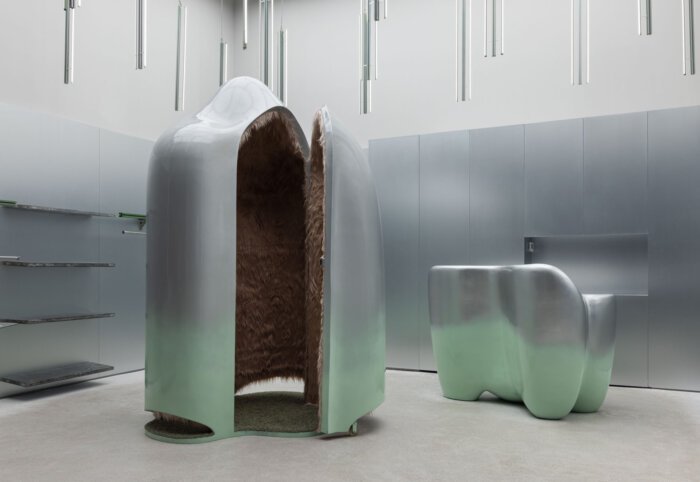
Sot, koncepti i vendosur i arkitekturës bazohet në një hierarki të gabuar midis natyrës dhe njerëzve. Me pretendimin për të rishpikur hapësirën në shekullin e kaluar, ne kemi përforcuar më tej nocionin e ndërtesave si objekte të pavarura, të ngritura mbi mjedisin. Lidhjet e thella me tokën dhe natyrën përmes teknologjive llogaritëse mund të na udhëheqin në ndërtimin e një të ardhmeje më të mirë. Nga kjo mund të krijohen koncepte të jashtëzakonshme për të krijuar vazhdimësi arkitekturore. Ky kërkim i tektonikës së re evoluon nga zbulimi i materializimit dhe fabrikimit, të cilat janë në thelb të kërkimit tonë arkitektonik.
Nëpërmjet kërkimit të metodave që synojnë të marrin mësim nga ndërtimi në terren, mund të vendoset një urë ndërmjet fazave të mbiklasifikuara të prodhimit arkitekturor. Gjenerimi i metodologjive të ndryshme specifike për çdo projekt mund të çojë në një riorganizim radikal për ta bërë arkitekturën përsëri pjesë të ekologjisë. Si një manifestim i krijimit të hapësirave në vazhdimësi me natyrën dhe tokën, Alper Derinboğaz ka udhëhequr studiot në kryqëzimin e praktikës dhe kërkimit nën çatinë e ‘Geospaces’ që nga viti 2011.


EN/
Roland Krebs, superwien urbanism zt gmbh
Time and Place: 9PM, 7th of July 2023, Kino Armata
Roland Krebs is an urban planner and designer from Vienna (Austria) who develops strategic action plans for cities to tackle urban growth. Since 1999, he has gained international experience in urban planning and design projects in Latin America and the Caribbean, Central and South Asia, Central and Southeast Europe, and Africa. He studied urban and regional planning at the Vienna University of Technology (TU WIEN) and graduated in strategic management (MBA) at the Universidad de Belgrano (UB) in Argentina, before receiving a postgraduate degree at Universitat Oberta de Catalunya (UOC) in Barcelona (Spain) in cooperation with Oficina del Historiador de La Habana (Cuba). Roland is a member of the chambers of architects in Vienna and Berlin and is currently Lead Expert at URBACT, the European Union’s cities program. Roland teaches urban planning and design at the TU WIEN, the University of Art and Design in Linz, and the University of Applied Sciences FH Campus Architecture and Green Buildings in Vienna. He is a co-founder of superwien and board member of wonder- land—platform for European architecture.
Superwien is a studio for urbanism and sustainable architecture based in Vienna (Austria). The company, founded by Roland Krebs and Stefan Mayr in 2017, is dedicated to supporting public institutions in their search for sustainable urban projects. Superwien is experienced in participatory and dialogue-oriented planning techniques within the framework of metropolitan and regional development plans, urban strategy plans, and master plans, as well as public space and placemaking projects. As consultants to multilateral organizations such as the World Bank, Asian Development Bank, European Bank for Reconstruction and Development, Inter-American Development Bank, the United Nations Development Program, and URBACT, the studio provides support for urban strategies and master plans of emerging cities in Latin America and the Caribbean, Central and South Asia, Sub-Saharan Africa, and the Western Balkans. In Western Europe, superwien is working on urban design, urban planning, master planning, and metropolitan planning projects—with a sound track record of winning architecture and urban design competitions.
About the Lecture:
Future Public Spaces – Urban Design in Times of Crisis
What does it take to renew or articulate a public space? When we strive for integrated urban development, we must acknowledge that public spaces can play many roles. They can be places for transit, or places for economic activity, social encounter, recreation, and much more. They also provide essential opportunities for the integration of green and blue infrastructures, which are becoming increasingly important for climate change adaptation. Needs for public space, and the demands made on them, are diverse; moreover, they are very specific to the local spatial and social conditions in which people live. Hence action at the neighborhood level is critical; it should involve interaction and co-creation with local residents to find out what they actually need. At the beginning of the COVID-19 pandemic, superwien was commissioned to develop innovative designs for urban public spaces in three cities: Dhaka (Bangladesh), Maputo (Mozambique), and Santo Domingo (Dominican Republic). The main objective of this applied research (in cooperation with four academic partners) was to strengthen the capacity of local government to carry out participatory urban design projects.
Recently, the team of superwien also worked in Prishtina over the last year and designed a catalgoue of proposals for the city and how it could develop in the next ten year toward a climate-friendly and creatvie metropolis in the network of thriving cities in the Western Balkans. https://vimeo.com/780651429
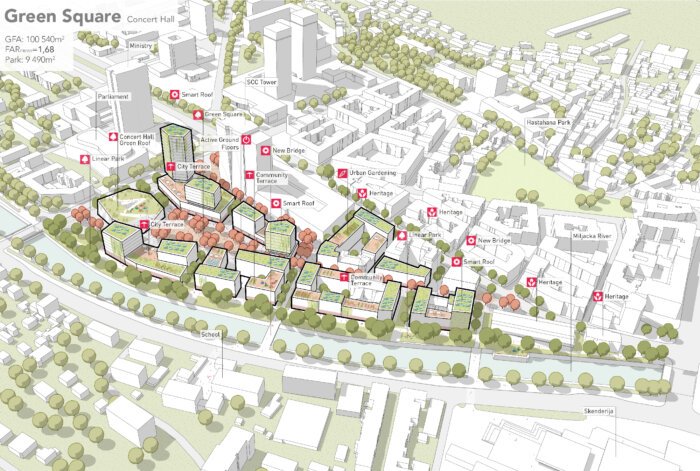
AL/
Roland Krebs, superwien urbanism zt gmbh
Koha dhe Vendi: 21:00 7 Korrik 2023, Kino Armata
Roland Krebs është një planifikues dhe projektues urban nga Vjena (Austri) i cili zhvillon plane zbatuese strategjike për qytetet për të trajtuar rritjen urbane. Që nga viti 1999, ai ka fituar përvojë ndërkombëtare në projektet e planifikimit dhe projektimit urban në Amerikën Latine dhe Karaibe, Azinë Qendrore dhe Jugore, Evropën Qendrore dhe Juglindore dhe Afrikë. Ka studiuar planifikimin urban dhe rajonal në Universitetin e Teknologjisë të Vjenës (TU WIEN) dhe u diplomua në menaxhim strategjik (MBA) në Universitetin Belgrano (UB) në Argjentinë, përpara se të merrte një diplomë pasuniversitare në Universitetin Oberta de Catalunya (UOC) në Barcelonë (Spanjë) në bashkëpunim me Oficina del Historiador de La Habana (Kubë). Roland është anëtar i dhomave të arkitektëve në Vjenë dhe Berlin dhe aktualisht është Ekspert Kryesor në URBACT, programi i qyteteve të Bashkimit Evropian. Roland jep mësime për planifikimin dhe dizajnin urban në TU WIEN, në Universitetin e Artit dhe Dizajnit në Linz dhe në Universitetin e Shkencave të Aplikuara FH Arkitekturë në Kampusin dhe Ndërtesat e Gjelbërta në Vjenë. Ai është një bashkëthemelues i superwien dhe anëtar bordi i platformës së tokës së mrekullive për arkitekturën evropiane.
Superwien është një studio për urbanizëm dhe arkitekturë të qëndrueshme me qendër në Vjenë (Austri). Kompania, e themeluar nga Roland Krebs dhe Stefan Mayr në 2017, është e përkushtuar për të mbështetur institucionet publike në kërkimin e tyre për projekte të qëndrueshme urbane. Superwien ka përvojë në teknikat e planifikimit me pjesëmarrje dhe të orientuar drejt dialogut brenda kuadrit të planeve të zhvillimit metropolitan dhe rajonal, planeve strategjike urbane dhe masterplaneve, si dhe projekteve të hapësirës publike dhe krijimit të vendeve. Si konsulentë të organizatave shumëpalëshe si Banka Botërore, Banka Aziatike për Zhvillim, Banka Evropiane për Rindërtim dhe Zhvillim, Banka Ndër- Amerikane për Zhvillim, Programi i Kombeve të Bashkuara për Zhvillim dhe URBACT, studio ofron mbështetje për strategjitë urbane dhe masterplanet e qyteteve në zhvillim në Amerikën Latine dhe Karaibe, Azinë Qendrore dhe Jugore, Afrikën Sub-Sahariane dhe Ballkanin Perëndimor. Në Evropën Perëndimore, superwien po punon për dizajn urban, planifikimit urban, masterplanit dhe planifikimit metropolitane – me një histori të shëndoshë të konkurseve fituese të arkitekturës dhe dizajnit urban.
Rreth Ligjëratës
Hapësirat publike të së ardhmes – Dizajni Urban në kohë krize
Çfarë nevojitet për të rinovuar apo artikuluar një hapësirë publike? Kur përpiqemi për zhvillim urban të integruar, duhet të pranojmë që hapësirat publike mund të luajnë shumë role. Ato mund të jenë vende për tranzit, ose vende për aktivitet ekonomik, takime shoqërore, rekreacion dhe shumë më tepër. Ato ofrojnë gjithashtu mundësi esenciale për integrimin e infrastrukturave te gjelbërta dhe të kaltërta, të cilat po bëhen gjithnjë e më të rëndësishme për përshtatjen ndaj ndryshimeve klimatike. Nevojat për hapësirë publike dhe kërkesat e bëra ndaj tyre janë të ndryshme; për më tepër, ato janë shumë specifike për kushtet lokale hapësinore dhe sociale në të cilat jetojnë njerëzit. Prandaj, veprimi në nivelin e lagjes është kritik; ai duhet të përfshijë ndërveprim dhe bashkë-krijim me banorët vendas për të zbuluar se çfarë kanë në të vërtetë nevojë. Në fillim të pandemisë COVID-19, superwien u angazhua të zhvillonte dizajne inovative për hapësirat publike urbane në tre qytete: Dhaka (Bangladesh), Maputo (Mozambik) dhe Santo Domingo (Republika Domenikane). Objektivi kryesor i këtij hulumtimi (në bashkëpunim me
katër partnerë akademikë) ishte për të forcuar kapacitetin e qeverisjes vendore për të realizuar projekte të dizajnit urban pjesmarës.
Kohët e fundit, ekipi i superwien punoi gjithashtu në Prishtinë gjatë vitit të kaluar dhe hartoi një katalog propozimesh për qytetin dhe se si ai mund të zhvillohet në dhjetë vitet e ardhshme drejt një metropoli miqësor ndaj klimës dhe në rrjetin e qyteteve të lulëzuara në Ballkanin Perëndimor.


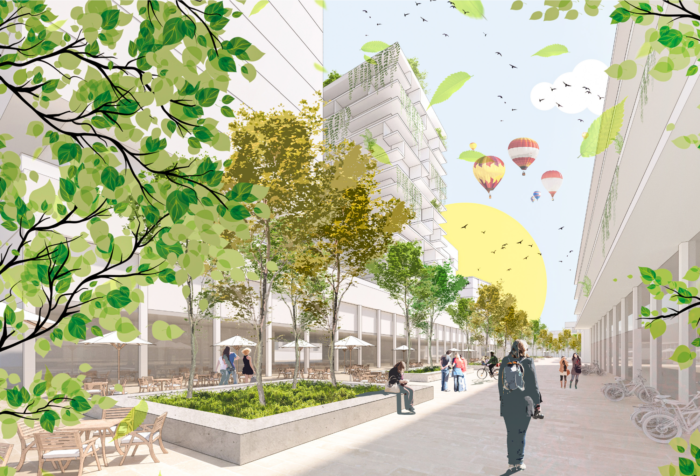

EN/
Poliksen Qorri-Dragaj & Hamdi Qorri
Time and Place: 8PM, 7th of July 2023, Kino Armata
Poliksen Qorri-Dragaj is an urban planner and research assistant at the Chair of Urban Planning at the RPTU Kaiserslautern-Landau, Germany. She studied architecture with specialization in urban planning at the Karlsruhe Institute of Technology. After graduating her studies in 2014, she worked as an urban planner at the planning office berchtoldkrass in Karlsruhe.
Her teaching focuses on urban design with an emphasis on urban climate adaptation, resilient urban development and mobility. As part of her PhD, she is researching the spatial effects of war and migration in Kosovar cities. Poliksen Qorri-Dragaj is currently participating in the research project “ReConstructionModules and Integrated Urban Development Ukraine” of RPTU Kaiserslautern-Landau, BTU Cottbus, TH Lübeck and TU Berlin, which is funded by the German Academic Exchange Service (DAAD). It offers teaching and exchange formats on topics related to the reconstruction of destroyed Ukrainian cities.
As an urban planner, her work ranges from classical framework planning and development concepts to mission statement development, interdisciplinary urban climate adaptation planning and overarching spatial analyses. Among others, Poliksen Qorri-Dragaj has led the following selected projects for berchtoldkrass:
Klimaanpassungskonzept / Climate Adaptation Concept, Freiburg im Breisgau: Due to its geographical location in the Upper Rhine Graben, the city of Freiburg i. Br. is one of the places with the highest average temperatures in Germany and is already feeling the effects of climate change on the well-being and health of its inhabitants. In order to actively and proactively counteract the future significantly increasing pressures, the climate adaptation concept was developed. The project was awarded in the “Climate Adaptation” category at the “Climate-Active Municipalities 2019” competition organized by the Federal Ministry for the Environment and the German Institute of Urban Affairs. It is nominated for the German Urban Development Prize 2023 in the category “Special Prize – Shaping Climate Change”, announced by the German Academy for Urban Development and Regional Planning (DASL)
Entwicklungsperspektive / Spatial development perspective Winterthur 2040: In recent years, the City of Winterthur has focused on carrying out long-term planning for areas with high pressure to act. The urban planning model shows how the city of Winterthur can develop sustainably by 2040. Future challenges for the city will be identified and the corresponding scope for development explored.
Mission Statement Baiersbronn Unterdorf: The project is accompanied by a broad public participation. The basic framework of the concept consists of three components: a “guideline” with the principles for the development, a “plan” for the concretization of the measures and a “script” for the presentation of the process. In the various projects Poliksen Qorri-Dragaj develops visualization strategies to represent urban planning concepts in digital and analog form.
About the Lecture
RKS² | TRANSCENDENT LOCALITY
Up to the present day, migration plays a significant role in the social development of Kosovo. It manifests itself in different forms, which differ in motives, manner and duration. The exhibition deals with a special form of migration, which illustrates that the migratory process is not completed with the simple move to another country. It often takes place in different phases, some of which end in a return to the home country. This return can be temporary, seasonal or permanent, but what they all have in common is that they ensure that connections and networks of different kinds are created between the homeland and the hostland. This form of migration can be described with the concept of translocality, a model of life that is becoming more and more prevalent – people living in multiple places at the same time, maintaining connections between hostland and homeland through communication, transfer of knowledge, information, material and immaterial goods.
In the course of the tense political situation and an ever-worsening marginalization of the Albanian population during the breakdown of the Yugoslavian Republic, hundreds of thousands of people sought refuge and protection abroad. In some cases, this flight would often last for decades without return.
During this conflict- and war-related migration wave in the late 1980s to the late 1990s, people fleeing found temporary arrival mostly in OECD countries, regulated in the form of a residence permit as politically persecuted persons. This legal status did not provide for a return to the homeland as long as the reason for flight had not been resolved and lifted. For many refugees, this represented a state of waiting and lingering, because the reason for migration was not a self-determined one – on the contrary, it was violently imposed from the outside.
The perceived locality of this migration group is the starting point for a spatial-philosophical narrative: transcendent locality. The concept of transcendence is variously described and defined from ancient to contemporary philosophy. Common to all meanings is that transcendence implies the process of crossing a boundary that separates two fundamentally different spheres.
For the individuals living in migration, the circumstance of not being able to return to their homeland for an indefinite period represented a deep caesura in their lives. On the one hand, the migrated individuals were physically present in the hostlands. superficially managing their everyday life and functioning in their new environment. But on the other hand, the emotional presence was a different matter: due to the conflict, attention and thoughts revolved around the abandoned homeland, fears and insecurities often did not allow the individuals to arrive in the hostland. They were located in an intermediate state between the physical present and the abandoned before. In this state, boundaries between the immanent being in the present and the transcendent being in the mind blur – the migrated individual is in a transcendent locality.
This project explores the impact of transcendent locality on immanent space in the short and long term: how the return of migrants after the war has affected Kosovar cities and how the social migration networks, which developed in the hostlands, impact on urban space in the form of translocal urbanism. It opens discussions on how urban planning can respond to these specific conditions in order to create urban resilience and liveable cities.
//
The installation serves as a metaphor for the idea of transcendence – the physical representation of a subjective state. It consists of an outer and an inner frame made of aluminium, in the middle of which a further frame made of neon tubes is located. All of these are multiplied horizontally.
Fragments
The installation is modularly assembled from individual parts. In the context of the project, this is how the transcendent locality is also composed. Individual fragments of memories and stories from the homeland are complemented by new impressions and experiences in the hostland and embed the transcendent locality in it. Memories and new impressions mean that this place is subject to a constant dynamic and never reaches a final state.
In between
Through migration, the center of life is left behind and, with increasing time, is supplemented by a second home in the hostland – this can be seen as a gain. Translocality, however, also strengthens the state of being in between.
The exterior and interior frames pick up on this motif as fixed constructions, in which the feeling of being in between is picked up by the neon.
Multiplication
The subjective confrontation and reflection with one’s own transcendent and immanent location in the context of migration is repeated again and again and becomes a constant companion.
The installation as a physical construct and as a metaphor depends very much on the individual perspective. Viewed from a distance, fragments, layers and spaces in between result in a coherent picture and, conversely, dissolve into their individual parts with increasing proximity – similar to the transcendent locality, which transforms into translocality and no longer lets people leave the intermediate state of proximity and distance between two places of being at home.

AL/
Poliksen Qorri-Dragaj & Hamdi Qorri
Koha dhe Vendi: 8 Korrik 2023, nga ora 20:00 ne Kino Armata
Poliksen Qorri Dragaj është urbaniste dhe asistente kërkimore në Katedrën e Planifikimit Urban në RPTU Kaiserslautern-Landau, Gjermani. Ajo ka studiuar arkitekturë me specializim në planifikim urban në Institutin e Teknologjisë në Karlsruhe. Pas diplomimit të studimeve në vitin 2014, ajo punoi si planifikuese urbane në zyrën e planifikimit berchtoldkrass në Karlsruhe.
Mësimdhënia e saj fokusohet në dizajnin urban me një theks në përshtatjen e klimës urbane, zhvillimin urban resilient dhe mobilitetit. Si pjesë e doktoratës së saj, ajo është duke hulumtuar efektet hapësinore të luftës dhe migrimit në qytetet kosovare. Poliksen Qorri-Dragaj aktualisht po merr pjesë në projektin kërkimor “ReConstructionModules and Integrated Urban Development Ukraine” të RPTU Kaiserslautern-Landau, BTU Cottbus, TH Lübeck dhe TU Berlin, i cili financohet nga Shërbimi Gjerman i Shkëmbimeve Akademike (DAAD). Ai ofron formate mësimore dhe shkëmbimi për tema që lidhen me rindërtimin e qyteteve të shkatërruara të Ukrainës.
Si një planifikuese urbane, puna e saj varion nga konceptet e planifikimit dhe zhvillimit klasik deri te zhvillimi i koncepteve urbane, planifikimi ndërdisiplinor i përshtatjes së klimës urbane dhe analizat gjithëpërfshirëse hapësinore. Ndër të tjera, Poliksen Qorri-Dragaj ka udhëhequr projektet e mëposhtme të përzgjedhura për berchtoldkrass:
Klimaanpassungskonzept / Koncepti i Përshtatjes Klimatike, Freiburg im Breisgau: Për shkak të vendndodhjes së tij gjeografike në Rhine Graben të Epërm, qyteti i Freiburg i. Br. është një nga vendet me temperaturat mesatare më të larta në Gjermani dhe tashmë po ndjen efektet e ndryshimeve klimatike në mirëqenien dhe shëndetin e banorëve të saj. Për të kundërshtuar në mënyrë aktive dhe proaktive presionet në rritje të konsiderueshme në të ardhmen, u zhvillua koncepti i përshtatjes klimatike. Projekti u vlerësua në kategorinë “Përshtatja klimatike” në konkursin “Bashkitë Aktive në Klimë 2019” organizuar nga Ministria Federale për Mjedisin dhe Instituti Gjerman i Çështjeve Urbane. Është nominuar për Çmimin Gjerman për Zhvillimin Urban 2023 në kategorinë “Çmimi Special – Formësimi i Ndryshimeve Klimatike”, shpallur nga Akademia Gjermane për Zhvillim Urban dhe Planifikim Rajonal (DASL)
Entwicklungsperspektive / Perspektiva e zhvillimit hapësinor Winterthur 2040: Në vitet e fundit, qyteti i Winterthur-it është fokusuar në kryerjen e planifikimit afatgjatë për zonat me presion të lartë për të vepruar. Modeli i planifikimit urban tregon se si qyteti i Winterthur-it mund të zhvillohet në mënyrë të qëndrueshme deri në vitin 2040. Sfidat e ardhshme për qytetin do të identifikohen dhe do të eksplorohet hapësira përkatëse për zhvillim.
Deklarata e Misionit Baiersbronn Unterdorf: Projekti shoqërohet nga një pjesëmarrje e gjerë publike. Kuadri bazë i konceptit përbëhet nga tre komponentë: një “udhëzues” me parimet e zhvillimit, një “plan” për konkretizimin e masave dhe një “skrip” për paraqitjen e procesit. Në projektet e ndryshme Poliksen Qorri-Dragaj zhvillon strategji vizualizimi për të përfaqësuar konceptet e planifikimit urban në formë dixhitale dhe analoge.
Rreth Ligjerates
Deri më sot, migrimi ka pasur rol të rëndësishëm në zhvillimin social të Kosovës. Manifestohet në forma të ndryshme, të cilat dallojnë për kah motivet, mënyra dhe kohëzgjatja. Ekspozita trajton një formë të veçantë të migrimit, e cila ilustron se procesi i migrimit nuk përfundon me shpërnguljen e thjeshtë në një vend tjetër. Shpesh zhvillohet në faza të ndryshme, disa prej të cilave përfundojnë me kthimin në vendlindje. Ky kthim mund të jetë i përkohshëm, sezonal ose i përhershëm, por e përbashkëta e tyre është se ato bëjnë të mundur krijimin e lidhjeve dhe rrjeteve të llojeve të ndryshme midis vendlindjes dhe vendit emigrues. Kjo formë migrimi mund të përshkruhet me konceptin e translokalitetit, një model jete që po bëhet gjithnjë e më i përhapur – njerëzit që jetojnë në shumë vende në të njëjtën kohë, duke ruajtur lidhjet midis vendlindjes dhe vendit emigrues përmes komunikimit, transferimit të njohurive, informacionit, të mirave materiale dhe jomateriale.
Në rrjedhën e situatës së tensionuar politike dhe një margjinalizimi të përkeqësuar të popullsisë shqiptare gjatë shpërbërjes së Republikës Jugosllave, qindra mijëra njerëz kërkuan strehim dhe mbrojtje jashtë vendit. Në disa raste, kjo ikje shpesh do të zgjaste për dekada pa kthim.
Gjatë kësaj vale të migrimit për shkak të konfliktit dhe luftës në fund të viteve ‘80 deri në fund të viteve ‘90, njerëzit që iknin gjetën strehim të përkoshëm kryesisht në vendet e OBZE-së, të rregulluar në formën e një leje qëndrimi si persona të përndjekur politikë. Ky status ligjor nuk parashihte kthim në vendlindje për sa kohë nuk i ishte dhënë zgjdihje dhe fund arsyes së ikjes. Për shumë refugjatë, kjo përfaqësonte një gjendje pritjeje dhe ngecjeje, sepse arsyeja e migrimit nuk ishte nga vetëdëshira– përkundrazi, ajo ishte e imponuar me dhunë nga jashtë.
Lokaliteti i perceptuar i këtij grupi migrues është pikënisja për një narrativë hapësinore-filozofike: lokalitet transcendent. Koncepti i transcendencës përshkruhet dhe përkufizohet në mënyra të ndryshme që nga filozofia e lashtë e deri në atë bashkëkohore. E përbashkët për të gjitha kuptimet është se transcendenca nënkupton procesin e kapërcimit të një kufiri që ndan dy sfera thelbësisht të ndryshme.
Për individët që jetonin në migrim, rrethana e moskthimit në vendlindje për një periudhë të pacaktuar përfaqësonte një cezurë të thellë në jetën e tyre. Nga njëra anë, individët e që migronin ishin fizikisht të pranishëm në vendet emigruese, duke menaxhuar në mënyrë sipërfaqësore jetën e tyre të përditshme dhe funksionimin në mjedisin e tyre të ri. Por nga ana tjetër, prania emocionale ishte një çështje tjetër: për shkak të konfliktit, vëmendjes dhe mendimeve që silleshin rreth vendlindjes së braktisur, frika dhe pasiguritë shpesh nuk i lejonin individët të arrinin në vendet e huaja. Ata ndodheshin në një gjendje të ndërmjetme midis të tashmes fizike dhe asaj të braktisur më parë. Në këtë gjendje, kufijtë midis qenies imanente në të tashmen dhe qenies transcendente në mendje mjegullohen – individi migrues e gjenë veten në një lokalitet transcendent.
Ky projekt hulumton ndikimin e lokalitetit transcendent në hapësirën imanente në periudhën afatshkurtër dhe afatgjatë: si ka ndikuar kthimi i migrantëve pas luftës në qytetet kosovare dhe si rrjetet sociale të migrimit, të cilat u zhvilluan në vendet emigruese, ndikojnë në hapësirën urbane në formën e urbanizmit translokal. Ai hap diskutime se si planifikimi urban mund t’i përgjigjet këtyre kushteve specifike në mënyrë që të krijojë qëndrueshmëri urbane dhe qytete të jetueshme.

Instalacioni shërben si një metaforë për idenë transcendente – paraqitjen fizike të një gjendjeje subjektive. Ai përbëhet nga një kornizë e jashtme dhe e brendshme prej alumini, në mes të së cilës ndodhet një kornizë e mëtejshme e bërë nga tuba neoni. Të gjitha këto shumëzohen horizontalisht.
Fragmente
Instalacioni është montuar në mënyrë modulare nga pjesë të veçanta. Në kuadër të projektit, kështu është i përbërë edhe lokaliteti transcendent. Fragmente të veçanta kujtimesh dhe tregimesh nga vendlindja plotësohen me përshtypje dhe përjetime të reja në vendet emigruese dhe ngulitin lokalitetin transcendent në të. Kujtimet dhe përshtypjet e reja nënkuptojnë se ky vend i nënshtrohet një dinamike të vazhdueshme dhe nuk arrin kurrë një gjendje përfundimtare.
Në mes
Nëpërmjet migrimit, pjesa qëndrore e jetës lihet pas dhe, me kalimin e kohës, ajo plotësohet nga një shtëpi e dytë në vendin emigrues – kjo mund të shihet si gjë e dobishme. Translokaliteti, megjithatë, forcon njëtrajtshëm gjendjen e të qenit në mes.
Kornizat e jashtme dhe të brendshme i trajtojnë këto motive si konstruksione të fiksuara, në të cilat ndjesia e të qenit në mes vërehet nga neoni.
Shumëzimi
Përballja dhe reflektimi subjektiv me vendndodhjen e vet transcendente dhe imanente në kontekstin e migrimit përsëritet dhe bëhet një bashkëudhëtar i vazhdueshëm.
Instalacioni si konstrukt fizik dhe si metaforë varet shumë nga këndvështrimi individual. Shikuar nga larg, fragmentet, shtresat dhe hapësirat në mes rezultojnë në një pamje koherente dhe, në mënyrë të kundërt, shkrihen në pjesët e tyre individuale duke rritur afërsinë – e ngjashme me lokalitetin transcendent, i cili shndërrohet në translokalitet dhe nuk i lë më njerëzit të largohen nga gjendja e ndërmjetme e afërsisë dhe distancës midis dy vendeve të të qenit në shtëpi.
